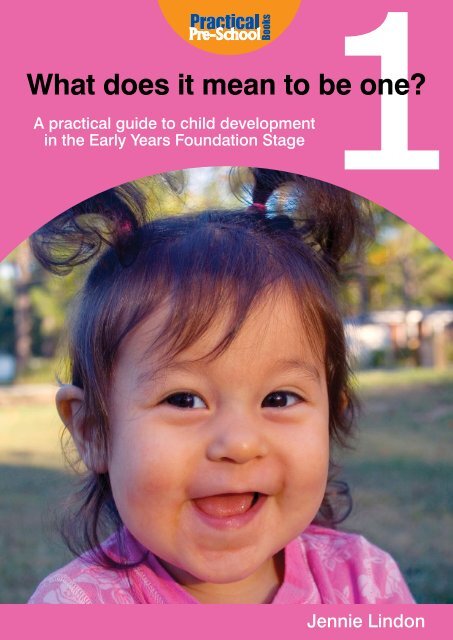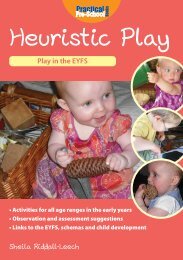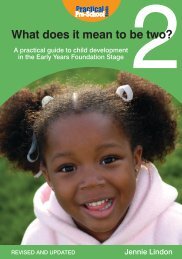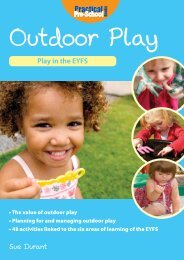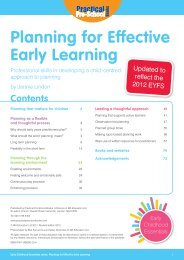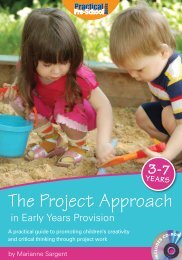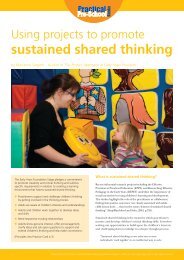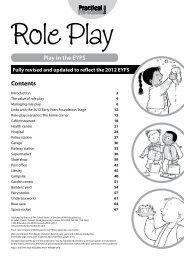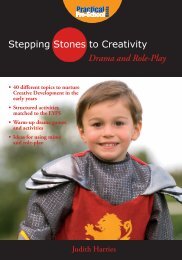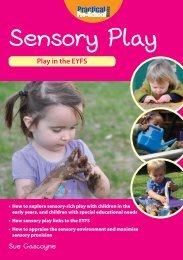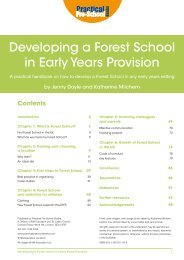What does it mean to be one? - Practical Pre-School Books
What does it mean to be one? - Practical Pre-School Books
What does it mean to be one? - Practical Pre-School Books
You also want an ePaper? Increase the reach of your titles
YUMPU automatically turns print PDFs into web optimized ePapers that Google loves.
1<br />
<strong>What</strong> <strong>does</strong> <strong>it</strong> <strong>mean</strong> <strong>to</strong> <strong>be</strong> <strong>one</strong>?<br />
A practical guide <strong>to</strong> child development <br />
in the Early Years Foundation Stage<br />
<strong>Books</strong><br />
<br />
Jennie Lindon
<strong>What</strong> <strong>does</strong> <strong>it</strong> <strong>mean</strong> <strong>to</strong> <strong>be</strong> <strong>one</strong>?<br />
<strong>Books</strong><br />
A practical guide <strong>to</strong> child development<br />
in the Early Years Foundation Stage<br />
Jennie Lindon<br />
1<br />
Contents<br />
Focus on <strong>one</strong>-year-olds 2-7<br />
Personal, social and emotional development 8-15<br />
Communication, language and l<strong>it</strong>eracy 16-23<br />
Problem solving, reasoning and numeracy 24-31<br />
Knowledge and understanding of the world 32-39<br />
Physical development 40-49<br />
Creative development 50-59<br />
<strong>What</strong> should concern you? 60<br />
Further resources 61-63<br />
Acknowledgements 64<br />
Published by <strong>Practical</strong> <strong>Pre</strong>-<strong>School</strong> <strong>Books</strong>, A Division of MA Education Ltd,<br />
St Jude’s Church, Dulwich Road, Herne Hill, London, SE24 0PB Tel. 020 7738 5454<br />
© MA Education Ltd 2009<br />
www.practicalpreschoolbooks.com<br />
Illustrations by Cathy Hughes. Front cover image © iS<strong>to</strong>ckpho<strong>to</strong>.com/William Mahnken<br />
All rights reserved. No part of this publication may <strong>be</strong> reproduced, s<strong>to</strong>red in a retrieval system, or transm<strong>it</strong>ted<br />
by any <strong>mean</strong>s, electronic, mechanical, pho<strong>to</strong>copied or otherwise, w<strong>it</strong>hout the prior permission of the publisher.<br />
<strong>What</strong> <strong>does</strong> <strong>it</strong> <strong>mean</strong> <strong>to</strong> <strong>be</strong> <strong>one</strong>? ISBN: 978 1 90457 586 3
Focus on <strong>one</strong> year olds<br />
Focus on <strong>one</strong>-year-olds<br />
<strong>What</strong> Does <strong>it</strong> Mean <strong>to</strong> <strong>be</strong> One? explores the developmental needs and likely skills of babies and<br />
young <strong>to</strong>ddlers. This book is part of a series that considers a year at a time in the life of very young<br />
children. This t<strong>it</strong>le now takes the series in<strong>to</strong> the very <strong>be</strong>ginning of early childhood and links<br />
closely w<strong>it</strong>h <strong>What</strong> <strong>does</strong> <strong>it</strong> <strong>mean</strong> <strong>to</strong> <strong>be</strong> two? The approach and ideas of this book are relevant <strong>to</strong> any<br />
pract<strong>it</strong>i<strong>one</strong>rs, working w<strong>it</strong>h babies and <strong>to</strong>ddlers anywhere in the UK. The structure of the book,<br />
however, follows the framework for England of the Early Years Foundation Stage: guidance covering<br />
from birth <strong>to</strong> five years of age that <strong>be</strong>came statu<strong>to</strong>ry for early years provision from Septem<strong>be</strong>r 2008.<br />
Children’s learning can only <strong>be</strong> effectively and appropriately supported when adults – pract<strong>it</strong>i<strong>one</strong>rs<br />
and parents alike – are guided by sound knowledge of child development. The layout of each of the<br />
five books in this linked series includes:<br />
• Descriptive developmental information w<strong>it</strong>hin the main text, organised w<strong>it</strong>hin the<br />
six areas of learning used by the Early Years Foundation Stage.<br />
• ‘For example’ sections giving instances of real children and real places and<br />
sometimes references <strong>to</strong> useful sources of further examples.<br />
• ‘Being a helpful adult’ boxes which focus on adult <strong>be</strong>haviour that is an effective support<br />
for children’s learning, as well as approaches that could undermine young children.<br />
• ‘Food for thought’ headings which highlight points of good practice in ways that<br />
can encourage reflection and discussion among pract<strong>it</strong>i<strong>one</strong>rs, as well as sharing in<br />
partnership w<strong>it</strong>h parents.<br />
<strong>What</strong><br />
<strong>does</strong><br />
<strong>it</strong> <strong>mean</strong> <strong>to</strong><br />
<strong>be</strong><br />
<strong>one</strong>?<br />
<br />
<strong>What</strong><br />
<strong>does</strong><br />
<strong>it</strong> <strong>mean</strong><br />
<strong>to</strong><br />
<strong>be</strong><br />
<strong>one</strong>?
Where are the <strong>one</strong>s in terms of early years provision?<br />
This book covers the baby year up <strong>to</strong> the first birthday and in<strong>to</strong> the year in which <strong>to</strong>ddlers are<br />
<strong>one</strong>. A huge amount happens developmentally over this time span and some babies and <strong>to</strong>ddlers<br />
will remain the full responsibil<strong>it</strong>y of their own family: parents or other adult family mem<strong>be</strong>rs.<br />
However, over the first part of very early childhood, some babies and <strong>to</strong>ddlers will experience the<br />
trans<strong>it</strong>ion in<strong>to</strong> some kind of non-family care, for part or all of their week.<br />
• Some of this age group will <strong>be</strong> cared for by somebody other than their parents, but<br />
w<strong>it</strong>hin a family home: by a nanny employed by the family <strong>to</strong> work in their home or<br />
w<strong>it</strong>h a childminder who is based in her, or occasionally his, own family home.<br />
• Other under <strong>one</strong>s and <strong>one</strong>s spend time in a group setting: a day nursery or a<br />
children’s centre. Unless the setting is very small, the under twos (often under<br />
threes) are likely <strong>to</strong> <strong>be</strong> in a separate base room from the over threes.<br />
Up <strong>to</strong> 2002 all national guidance across the UK was focussed on the over threes. England,<br />
Scotland and Wales each had their own early years curriculum document <strong>to</strong> guide pract<strong>it</strong>i<strong>one</strong>rs<br />
working w<strong>it</strong>h three- <strong>to</strong> five-year-olds. The framework for Northern Ireland covered three- and<br />
four-year-olds, since young children start primary school in the Septem<strong>be</strong>r of the school year after<br />
their fourth birthday. Any guidance about good practice w<strong>it</strong>h under threes was developed w<strong>it</strong>hin<br />
a local area by early years teams who were concerned about guiding or enhancing the qual<strong>it</strong>y of<br />
provision. Then, in 2002 the Birth <strong>to</strong> Three Matters framework was introduced in England, and in<br />
2005 Scotland launched their Birth <strong>to</strong> Three: Supporting our Youngest Children framework.<br />
The most recent changes are that:<br />
• In England from Septem<strong>be</strong>r 2008 the birth <strong>to</strong> five Early Years Foundation Stage<br />
(EYFS) has replaced both the under-threes Birth <strong>to</strong> Three Matters, and the Foundation<br />
Stage for three-<strong>to</strong> five-year-old.<br />
• In Scotland, the current developments for change revolve around a Curriculum for<br />
Excellence set <strong>to</strong> cover all children from three <strong>to</strong> eighteen years of age. In the earlier<br />
years, the main focus for development is for a continu<strong>it</strong>y of more active learning and<br />
play from the early education of three-<strong>to</strong> five-year-olds in<strong>to</strong> the first years of primary<br />
school. The Scottish birth <strong>to</strong> three guidance remains the framework for good<br />
practice w<strong>it</strong>h this youngest age range.<br />
• In Wales, the main focus of development is on the Foundation Phase for young<br />
children from three <strong>to</strong> seven years, bridging the early years curriculum in<strong>to</strong> the first<br />
years of primary school. There is no national under threes guidance in Wales.<br />
• In Northern Ireland the early years curriculum applies <strong>to</strong> three- and four-year-olds,<br />
often mainly threes. There is no national under threes guidance and the main focus<br />
for current development has <strong>be</strong>en the Foundation Stage that applies <strong>to</strong> the first two<br />
years of primary school, w<strong>it</strong>h children aged four or five years of age. However, over<br />
2009 the Department of Education is working on an early years strategy for the age<br />
span of birth <strong>to</strong> six years.<br />
The English and Scottish under threes materials had a different appearance and overall structure,<br />
but otherwise they had a great deal in common, <strong>be</strong>cause the teams drew on the same source<br />
materials, including research about very early development. These strands for good practice now<br />
run throughout the 0-5 EYFS as consistent themes in developmentally appropriate practice: the<br />
importance of secure attachment w<strong>it</strong>hin early childhood, that making a personal relationship w<strong>it</strong>h<br />
children is a non-negotiable part of early years professionalism and that nurture is an essential<br />
part of good and safe practice.<br />
<strong>What</strong><br />
<strong>does</strong><br />
<strong>it</strong> <strong>mean</strong> <strong>to</strong><br />
<strong>be</strong><br />
<strong>one</strong>?<br />
<br />
<strong>What</strong><br />
<strong>does</strong><br />
<strong>it</strong> <strong>mean</strong><br />
<strong>to</strong><br />
<strong>be</strong><br />
<strong>one</strong>?
Communication, Language and L<strong>it</strong>eracy<br />
Food for thought<br />
Children need good reasons – from<br />
their point of view – <strong>to</strong> want <strong>to</strong> talk<br />
and <strong>to</strong> listen. They need plenty of<br />
early experiences of familiar adults<br />
who listen <strong>to</strong> them. Normal life<br />
for <strong>to</strong>ddlers and young children<br />
is having <strong>to</strong> struggle w<strong>it</strong>h the<br />
search for words and <strong>to</strong>lerating the<br />
frustrations of making other people<br />
understand.<br />
Babies and <strong>to</strong>ddlers will persevere<br />
in this task and will relish personal<br />
exchanges when their key person,<br />
parent and other familiar adults<br />
show that they genuinely enjoy<br />
chatting w<strong>it</strong>h this older baby and<br />
<strong>to</strong>ddler right now. Young <strong>to</strong>ddlers<br />
forgive those times when a familiar<br />
adult seems <strong>to</strong> <strong>be</strong> very dense and<br />
fails <strong>to</strong> understand what is obvious<br />
<strong>to</strong> the gesticulating <strong>to</strong>ddler.<br />
Communication,<br />
Language and L<strong>it</strong>eracy<br />
The Every Child a Talker (ECaT) programme, launched by the Department for Children<br />
<strong>School</strong>s and Families in 2009, addresses the need for every<strong>one</strong> <strong>to</strong> focus on communication over<br />
early childhood. The guidance homes in on the serious consequences for children when their<br />
early experiences have not supported them <strong>to</strong> <strong>be</strong>come communicative, keen <strong>to</strong> talk and voice<br />
their ideas, able <strong>to</strong> listen and <strong>to</strong> participate in the turn taking of genuine conversation.<br />
There can <strong>be</strong> a significant gap in the size of children’s working vocabulary <strong>be</strong>tween those who<br />
have had a good start in communication and those children who have <strong>be</strong>en poorly served by<br />
their early experiences.<br />
• The desire <strong>to</strong> communicate and the steady building of vocabulary are well supported<br />
by natural, daily exchanges that arise through shared play and joint experiences.<br />
• Helpful adults do not s<strong>it</strong> down <strong>to</strong> plan structured ‘communication activ<strong>it</strong>ies’ – not<br />
w<strong>it</strong>h any young children and certainly not w<strong>it</strong>h babies or <strong>to</strong>ddlers.<br />
• Communication is personal and flows from what interests this baby, <strong>to</strong>ddler or child<br />
<strong>to</strong>day. Simple works - what really matters is that adults listen <strong>to</strong>, talk w<strong>it</strong>h, interact<br />
and play w<strong>it</strong>h babies and young children.<br />
• The support from a planful adult outlook is that opportun<strong>it</strong>ies and experiences<br />
are offered (not imposed) which, from pract<strong>it</strong>i<strong>one</strong>rs’ knowledge of individual<br />
children, are likely <strong>to</strong> interest and exc<strong>it</strong>e them.<br />
• Young children will not need special language programmes and remedial help, so<br />
long as their early years have <strong>be</strong>en full of personal, attentive communication – at<br />
home but also in their out-of-home provision.<br />
Babies as active communica<strong>to</strong>rs<br />
Observant parents and early years pract<strong>it</strong>i<strong>one</strong>rs have always commented<br />
on the alertness of babies and how much happens <strong>be</strong>fore the first<br />
recognisable words. Mothers, and involved fathers <strong>to</strong>o, were sure<br />
that their babies were responding w<strong>it</strong>h interest <strong>to</strong> what was said, long<br />
<strong>be</strong>fore they could understand any of the content expressed in words.<br />
The options from video technology in the 1970s led <strong>to</strong> very detailed<br />
research projects in which babies of only a few months old and their<br />
mothers were filmed in close interaction. The video footage was then<br />
analysed frame by frame. Several research teams were active in this work<br />
and <strong>one</strong> was led by Colwyn Trevarthen, who is still fully engaged in<br />
research about the patterns of very early communication<br />
It <strong>be</strong>came clear that:<br />
• Young babies were an active partner in these very early<br />
conversations and not simply passive followers of what their<br />
<strong>What</strong><br />
<strong>does</strong><br />
<strong>it</strong> <strong>mean</strong> <strong>to</strong><br />
<strong>be</strong><br />
<strong>one</strong>?<br />
16<br />
<strong>What</strong><br />
<strong>does</strong><br />
<strong>it</strong> <strong>mean</strong><br />
<strong>to</strong><br />
<strong>be</strong><br />
<strong>one</strong>?
mother did. They im<strong>it</strong>ated their mother’s expression but were also active in their<br />
own facial expressions and waving hands and feet.<br />
• Babies were able <strong>to</strong> pause and look expectant. They had learned something of the<br />
timing of a conversation, <strong>be</strong>cause their mother communicated regularly in this way.<br />
• Babies reacted <strong>to</strong> changes in their mother’s <strong>to</strong>ne. They were also very aware if<br />
their mother’s attention was distracted, as was sometimes deli<strong>be</strong>rately created by<br />
an interruption in some studies. Babies made physically active and sound-making<br />
attempts <strong>to</strong> regain her full attention.<br />
• There was also evidence that the babies had a subtle grasp of the give-and-take of<br />
a proper exchange. When babies were shown a video of their mother, they soon<br />
changed from happy communication <strong>to</strong> signs of confusion, and then distress. The<br />
only interpretation was that the reactions of the familiar face on the screen failed<br />
<strong>to</strong> f<strong>it</strong> what the baby had just ‘said’. The timing was awry, the video of the mother’s<br />
reactions were not attuned <strong>to</strong> the emotional <strong>to</strong>ne of her real baby. Young babies very<br />
soon <strong>be</strong>came aware of the mismatch.<br />
The 1970s and 1980s studies used mother and baby pairs and called the subtle adult<br />
communication w<strong>it</strong>h babies ‘motherese’. However, this kind of adjusted communication, that<br />
is so very su<strong>it</strong>able for babies, is not the sole terr<strong>it</strong>ory of mothers, nor of women. Nor is the<br />
communication style used only by parents, so ‘parentese’ is not much of an improvement as<br />
a term. Men, as fathers or early years pract<strong>it</strong>i<strong>one</strong>rs, are completely capable of adjusting their<br />
communication in this way. So <strong>it</strong> is <strong>be</strong>tter called a phrase like ‘infant-directed speech’. Older<br />
children, who probably copy familiar adults, also sometimes produce this kind of talk w<strong>it</strong>h babies<br />
they know, not always their own siblings. The delighted reaction from the baby is encouragement<br />
<strong>to</strong> continue.<br />
The characteristics of effective infant-directed speech are as follows:<br />
Being a helpful adult<br />
The video-based research of<br />
babies is three decades old, but as<br />
relevant as ever. The v<strong>it</strong>al insights<br />
about early communication and the<br />
sens<strong>it</strong>iv<strong>it</strong>y of babies are applicable<br />
<strong>to</strong> the exchanges <strong>be</strong>tween caring<br />
adults (of e<strong>it</strong>her sex) and a baby.<br />
• Even babies of a few months<br />
old are keen <strong>to</strong> communicate.<br />
They are responsive <strong>to</strong><br />
affectionate attention from an<br />
adult – and also from familiar<br />
older children, who can <strong>be</strong> very<br />
patient in chatting w<strong>it</strong>h babies.<br />
• Babies’ alertness at this stage<br />
is based on hearing familiar<br />
voices, reassuring talk and<br />
singing from the earliest weeks.<br />
• The adult needs <strong>to</strong> stay close<br />
and never see communication<br />
w<strong>it</strong>h a baby as something<br />
that can interrupted by more<br />
‘important’ tasks.<br />
• You have <strong>to</strong> <strong>be</strong> close <strong>to</strong> babies so that your faces are in close proxim<strong>it</strong>y and they can<br />
see your eyes and facial expression. You might <strong>be</strong> chatting in this way as you change<br />
their nappy, s<strong>it</strong>ting w<strong>it</strong>h them on your lap or <strong>be</strong>side them as they lay on their back on<br />
a comfortable floor.<br />
• It <strong>does</strong> not matter what you say, so long as you look interested. Use ordinary words,<br />
there is no advantage, and some drawbacks, if you introduce ‘baby talk’ and change<br />
words, like saying ‘bikky’ or ‘gee gee’.<br />
• Keep what you say simple and your phrases short. Pause and look expectant, so that<br />
the baby learns <strong>it</strong> is now her turn <strong>to</strong> ‘say’ something.<br />
• Be more expressive than in usual speech, both in how you say the words and in your facial<br />
expressions. Use your eyes, mouth and facial muscles <strong>to</strong> add <strong>to</strong> the communication.<br />
• Babies seem <strong>to</strong> like voices <strong>to</strong> <strong>be</strong> slightly higher p<strong>it</strong>ched than the normal adult <strong>to</strong>ne. On<br />
average, women have a higher p<strong>it</strong>ched voice, but men can go up a b<strong>it</strong> in p<strong>it</strong>ch w<strong>it</strong>hout<br />
straining or sounding odd. For instance, watch three-month old Charlotte and her father,<br />
as he changes her nappy and chats, in Firm foundations for early l<strong>it</strong>eracy (Siren Films 2009).<br />
• <strong>What</strong> works <strong>be</strong>st is sing-song style, w<strong>it</strong>h a circling and repet<strong>it</strong>ive qual<strong>it</strong>y. You repeat<br />
or half-repeat a phrase that has caught the baby’s attention, such as, ‘Is that a<br />
rasp<strong>be</strong>rry? Did you blow a rasp<strong>be</strong>rry at me?’<br />
• Follow a relaxed rhythm, so the baby has the time <strong>to</strong> express their sounds, make<br />
their facial expression or wave their hands at you. If you go <strong>to</strong>o fast, then you end up<br />
talking over the baby’s contribution <strong>to</strong> the conversation.<br />
• Be ready <strong>to</strong> follow the baby’s lead, in sounds or facial expression. You are partners in<br />
this exchange and <strong>it</strong> is a delight <strong>to</strong> babies (and <strong>to</strong>ddlers as well) when you copy them.<br />
<strong>What</strong><br />
<strong>does</strong><br />
<strong>it</strong> <strong>mean</strong> <strong>to</strong><br />
<strong>be</strong><br />
<strong>one</strong>?<br />
17<br />
<strong>What</strong><br />
<strong>does</strong><br />
<strong>it</strong> <strong>mean</strong><br />
<strong>to</strong><br />
<strong>be</strong><br />
<strong>one</strong>?


